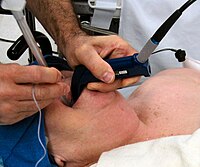
Photo from wikipedia
OBJECTIVES To study: 1) the effect of prone position (PP) on noninvasive ventilation (NIV)-delivered mechanical power (MP) and 2) the impact of MP on physio-anatomical and clinical responses to early… Click to show full abstract
OBJECTIVES To study: 1) the effect of prone position (PP) on noninvasive ventilation (NIV)-delivered mechanical power (MP) and 2) the impact of MP on physio-anatomical and clinical responses to early versus late PP in severe acute respiratory syndrome coronavirus 2 (SARS-CoV-2) pneumonia. DESIGN Nonrandomized trial with inverse probability of treatment weighted-matched groups. SETTING HUMANITAS Gradenigo Sub-ICU. PATIENTS One hundred thirty-eight SARS-CoV-2 pneumonia patients with moderate-to-severe acute hypoxemic respiratory failure (Pao2/Fio2 ratio < 200 mm Hg) receiving NIV from September 1, 2020, to February 28, 2021 (Ethics approval: ISRCTN23016116). INTERVENTIONS Early PP or late PP or supine position. MEASUREMENTS AND MAIN RESULTS Respiratory parameters were hourly recorded. Time-weighted average MP values were calculated for each ventilatory session. Gas exchange parameters and ventilatory ratio (VR) were measured 1 hour after each postural change. Lung ultrasonographic scores and circulating biomarkers were assessed daily. MP delivered during the initial 24 hours of NIV (MP [first 24 hr]) was the primary exposure variable. Primary outcomes: 28-day endotracheal intubation and death. Secondary outcomes: oxygen-response, Co2-response, ultrasonographic, and systemic inflammatory biomarker responses after 24 hours of NIV. Fifty-eight patients received early PP + NIV, 26 late PP + NIV, and 54 supine NIV. Early PP group had lower 28-day intubation and death than late PP (hazard ratio [HR], 0.35; 95% CI, 0.19-0.69 and HR, 0.26; 95% CI, 0.07-0.67, respectively) and supine group. In Cox multivariate analysis, (MP [first 24 hr]) predicted 28-day intubation (HR, 1.70; 95% CI, 1.25-2.09; p = 0.009) and death (HR, 1.51; 95% CI, 1.19-1.91; p = 0.007). Compared with supine position, PP was associated with a 35% MP reduction. VR, ultrasonographic scores, and inflammatory biomarkers improved after 24 hours of NIV in the early PP, but not in late PP or supine group. A MP (first 24 hr) greater than or equal to 17.9 J/min was associated with 28-day death (area under the curve, 0.92; 95% CI, 0.88-0.96; p < 0.001); cumulative hours of MP greater than or equal to 17.9 J/min delivered before PP initiation attenuated VR, ultrasonographic, and biomarker responses to PP. CONCLUSIONS MP delivered by NIV during initial 24 hours predicts clinical outcomes. PP curtails MP, but cumulative hours of NIV with MP greater than or equal to 17.9 J/min delivered before PP initiation attenuate the benefits of PP.
Journal Title: Critical care medicine
Year Published: 2023
Link to full text (if available)
Share on Social Media: Sign Up to like & get
recommendations!